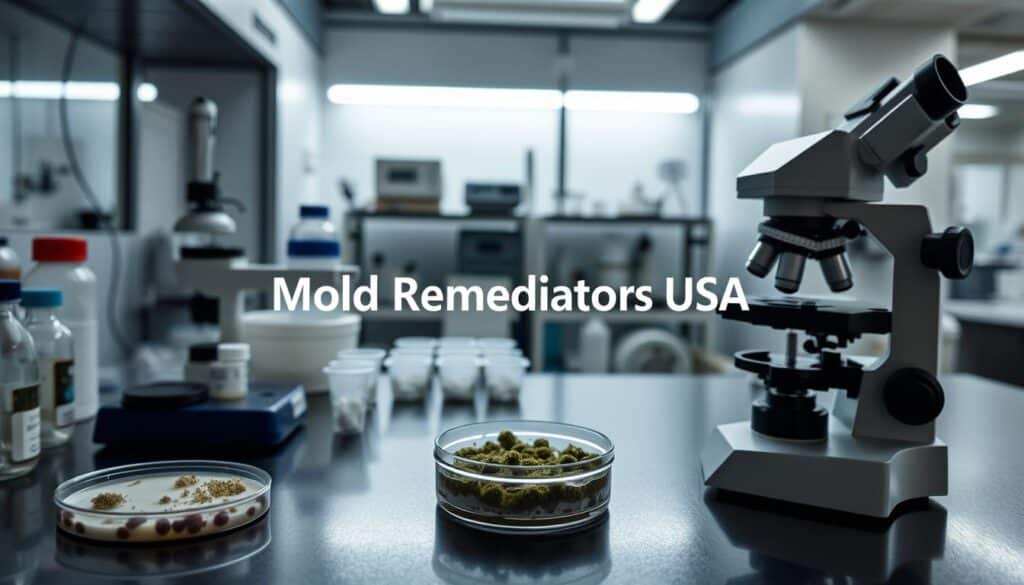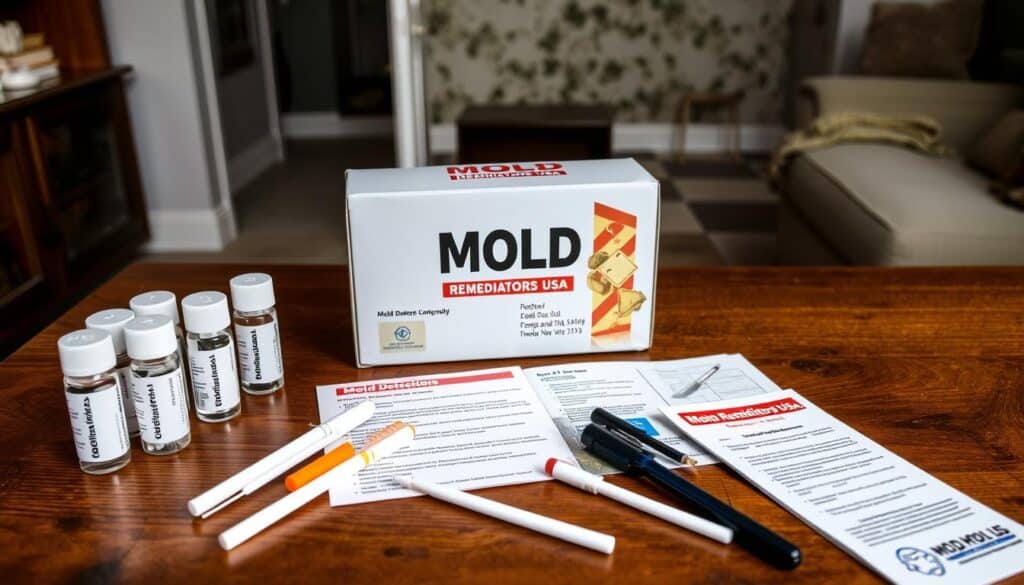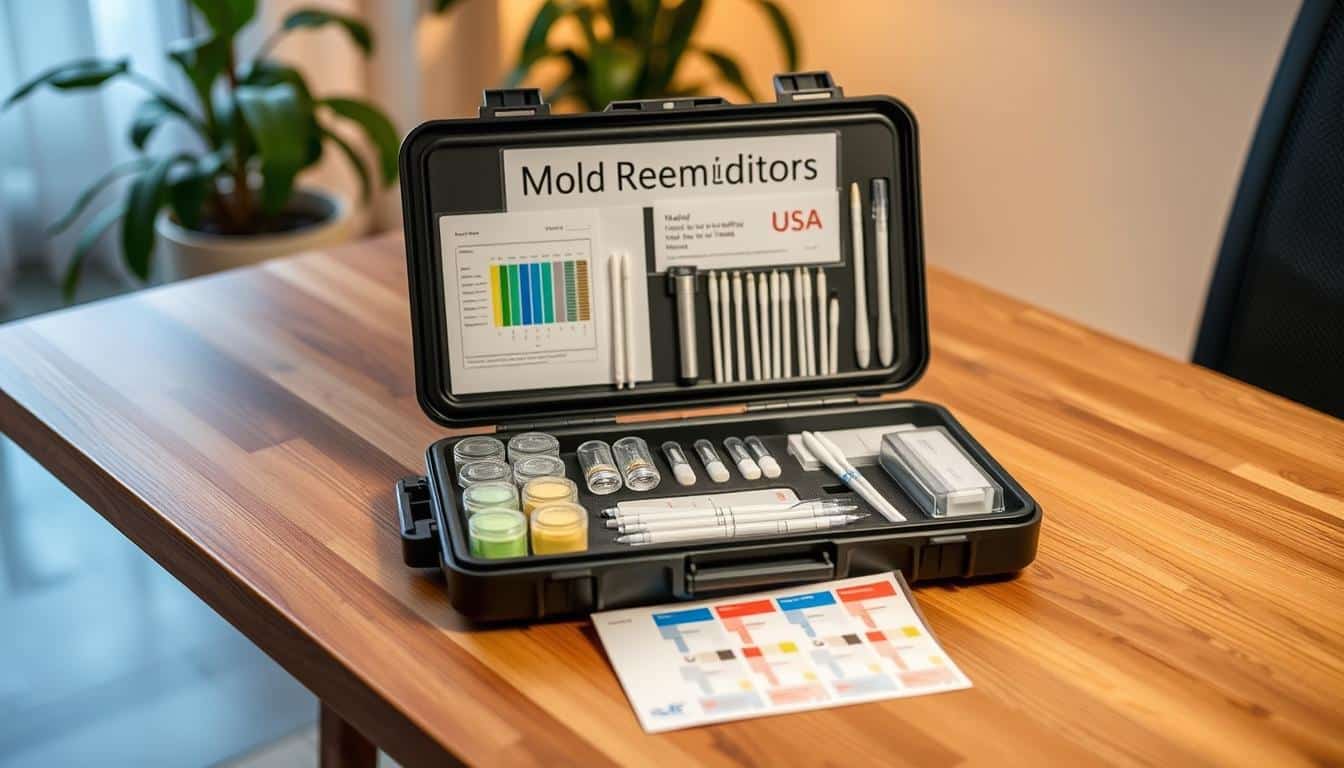Did you know that over 50% of mold inspections find water problems or humidity over 60% in homes? These issues are the main reasons for mold growth. They can harm your health and damage your property. As a homeowner, I’ve often wondered if DIY mold test kits can really find these dangers. In this review, I’ll share my honest thoughts on whether these kits work for mold detection and improving indoor air quality.
Mold exposure can cause many health problems, like coughing, sneezing, and headaches. It can also lead to respiratory issues, fatigue, and flu-like symptoms. This is why home mold inspection kits have become popular. They let you test for mold on your own, but their accuracy is often questioned.
Some kits only check for certain mold spores, while others can detect more. The price of these kits varies a lot, and how fast you get results also differs. In this review, I’ll look at the good and bad of DIY mold testing. I’ll also compare it to professional inspections to help you decide about moisture problems in your home.
Key Takeaways
- Over half of mold inspections reveal water issues in homes
- Mold exposure can cause various health problems
- DIY mold test kits vary in detection capabilities and cost
- Professional mold testing tools offer more precise detection
- The EPA advises testing after cleanup to ensure effective mold removal
Understanding Mold and Its Health Risks
Mold is a big problem in homes across the United States. About 70% of U.S. homes have mold, which grows both inside and outside. This fungus can cause serious health issues and damage to your property if not treated.
What is Mold?
Mold is a fungus that grows in strands called hyphae. It thrives in damp places and comes in different colors and textures. Mold spreads by releasing spores into the air, which can be found through air sampling.
Common Types of Household Mold
There are many types of mold found in homes, each with its own health risks. Here’s a table showing some common household molds:
| Mold Type | Appearance | Common Locations | Health Risks |
|---|---|---|---|
| Penicillium | Blue-green, gray-green | Carpets, wallpaper, ducting | Allergies, asthma |
| Aspergillus | Yellow-green, gray | Damp walls, ceilings | Respiratory infections |
| Cladosporium | Olive-green, brown | Fabrics, wood surfaces | Skin lesions, lung infections |
| Stachybotrys (Black Mold) | Black, slimy | Damp cellulose materials | Severe respiratory issues |
Health Implications of Mold Exposure
Mold exposure can cause a range of health problems, from mild to severe. It can lead to allergic reactions, respiratory issues, and even neurological problems or death. The health risks depend on the mold type and the amount of spores in the air.
If the concentration of mold spores exceeds 500 spores per cubic meter of air, it’s considered high and potentially harmful3.
To find out how much mold is present and what health risks it poses, different testing methods are used. These include air sampling, surface sampling, and bulk sampling. Early detection through home tests can prevent property damage and help you decide on the right remediation.
If you think you have mold in your home, it’s important to act fast. While home testing kits can give you an idea, it’s best to get professional help for accurate results and effective solutions.
The Importance of Accurate Mold Detection
Finding mold accurately is key to keeping our air clean and our health safe. Mold spores are everywhere, making it hard to spot bad growth. This shows why we need exact methods to find mold during home checks.
DIY mold test kits are not always reliable. In fact, more than 80% of them give wrong results. This can mean missing serious mold or worrying about nothing.

Professional tools are better for finding mold. They count air particles for exact results. Lab tests can spot many mold types and how much there is, helping fix problems right.
Mold can hide in places DIY kits can’t reach, like walls or under floors. This shows why we need experts to find and fix moisture issues for a healthy home.
“Accurate mold detection is not just about finding visible growth. It’s about understanding the full scope of the problem to protect our health and homes.”
| Aspect | DIY Mold Test Kits | Professional Mold Testing |
|---|---|---|
| Accuracy | Over 80% inaccurate | High precision |
| Detection Range | Limited | Comprehensive |
| Hidden Mold Detection | No | Yes |
| Species Identification | Limited | Hundreds of species |
The need for accurate mold detection is huge. It’s not just about seeing mold; it’s about knowing all the moisture issues to keep us safe and healthy.
Types of Mold Test Kits Available
As a homeowner worried about mold, I looked into different mold test kits. These kits help find mold and come in various types. Each type is made for different testing needs.
Air Sampling Kits
Air sampling kits measure mold spores in the air. The Mold Armor Do It Yourself Mold Test Kit tests surfaces and air. It gives results in 48 hours. For ongoing air quality checks, the Airthings 4200 House Kit Air Quality Monitor is great. It tracks air quality, including mold spores7.
Surface Sampling Kits
Surface sampling kits find visible mold. The Seeml Labs DIY Mold Test Kit uses swabs and tape strips. It sends samples to the lab for quick results in one day. These kits are good for checking places like showers, sinks, and basements.
Bulk Sampling Kits
Bulk sampling kits test materials for mold. The PRO-LAB® MOLD TEST KIT costs $49.95 and tests bulk samples. It also offers other testing options. This kit can find mold in many household items.
When picking a mold test kit, think about how fast you get results and lab fees. Some kits, like the ImmunoLytics DIY Mold Test Kit, let you analyze samples yourself. You get results in 5 to 7 days. Others, like the LabTech® Mold OK™ Detection Kit, send samples to a lab for $15 each.
“Mold test kits are valuable tools for homeowners, but understanding their limitations is crucial for effective mold detection and management.”
While these kits are useful, they might not show the whole picture of mold in your home. If you’re worried about mold health issues, getting a professional mold inspector is a good idea.
Do Mold Test Kits Work?
Mold test kits are popular for finding mold at home. But, their ability to do so accurately is in doubt. These kits can spot mold, but they often don’t give reliable results.
DIY mold test kits have big drawbacks. They don’t have expiration dates, which means they can get contaminated. The way they’re shipped and handled can lead to wrong results. Plus, many kits don’t include a control sample, making results even less trustworthy.

Professional mold inspections are a better way to check indoor air quality. They use special tools like infrared thermography and moisture meters. Experts can find hidden mold and understand results well, offering real solutions.
Some studies say DIY mold test kits work, but Consumer Reports found four brands not recommended. This shows we should be careful using DIY kits for mold detection alone.
DIY mold test kits can be a starting point, but they shouldn’t replace professional home inspections for comprehensive mold assessment.
| Aspect | DIY Mold Test Kits | Professional Mold Inspection |
|---|---|---|
| Accuracy | Limited, prone to errors | High, uses advanced techniques |
| Comprehensiveness | Detects surface mold only | Identifies hidden mold |
| Result Interpretation | Often unclear or misleading | Expert analysis provided |
| Cost | Lower initial cost | Higher cost, more value |
In conclusion, DIY mold test kits can start the process of finding mold. But, they can’t replace professional home inspections for a full check of your indoor air quality.
Pros and Cons of DIY Mold Testing
DIY mold testing kits are popular among homeowners who want to check their indoor air quality. These kits cost between $10 and $40 and seem like a cheap way to find mold. But are they really good? Let’s look at the good and bad sides of home mold test kits.
Advantages of Home Mold Test Kits
DIY mold testing kits are easy to find and seem cheap. They’re sold at home improvement stores and online, making it seem simple to test for mold. Some kits test surfaces, while others check for mold spores in the air. This gives you options in how you test.
Limitations of DIY Mold Testing
Despite being easy to use, DIY mold test kits have big problems. Experts say these kits often don’t give accurate results. This is because of bad lab work, faulty equipment, and poor sampling materials. Consumer Reports even says DIY mold tests are “Not Recommended” because of leakage, contamination risks, and wrong mold spore identification.
One big issue is that DIY kits can’t do visual inspections. Professional mold testing services do thorough visual checks, which DIY kits can’t do. This means DIY testers might miss hidden mold, which could be harmful.
Also, DIY kits often use uncalibrated pumps, which can give wrong mold level readings. The results can be all over the place because of labs that aren’t certified. This can lead to wrong findings and misunderstandings of test results.
In short, while DIY mold test kits might look good, they have big problems with accuracy and detail. For real results and to make smart choices about indoor air quality, it’s best to use qualified mold testing professionals.
Comparing Home Kits to Professional Mold Inspections
Home mold test kits and professional inspections differ a lot. DIY kits might seem easy, but they’re not always accurate. Professional air samples give detailed info on mold types and counts, showing better indoor air quality.
The Environmental Protection Agency (EPA) warns against using DIY mold test kits. These kits can lead to wrong results because of sampling mistakes. The EPA suggests getting professional mold sampling from experts.
- Thorough visual assessments
- Use of specialized equipment
- Expert result interpretation
- Identification of hidden mold
- Pinpointing moisture sources
Professionals offer a full check of your home’s mold situation. They give detailed plans for fixing mold, which is key for removing it well.
DIY fixes might work for small mold spots, like in bathrooms. But big problems or health worries need a pro’s help. For big areas or health issues, getting a pro to inspect and fix mold is best. This way, you get mold removed right and air quality improves.
If you see or smell mold, don’t wait. It’s time to act. For sure results and peace of mind, go for a professional mold check instead of DIY kits.
Factors Affecting Mold Test Kit Accuracy
Several factors can affect how well mold test kits work. Knowing these factors is key to finding mold and getting accurate results.
Environmental Conditions
Temperature and humidity are big factors in mold growth. These can make test results false or misleading. Changes in these conditions can also affect air sampling and spore counts.
Sampling Techniques
The method used for sampling is very important. Petri dish kits are common but don’t give exact mold levels. Air pump kits, on the other hand, give a clearer picture of air quality and mold exposure.
User Error
DIY mold test kits can be tricky to use correctly. Over 80% of these kits give wrong results because of user mistakes. Not knowing how to use the kits can lead to wrong spore counts.
| Factor | Impact on Accuracy | Professional Solution |
|---|---|---|
| Environmental Conditions | Can cause false positives/negatives | Controlled sampling environment |
| Sampling Techniques | Varied accuracy based on method | Use of calibrated equipment |
| User Error | High risk of inaccurate results | Expert handling and analysis |
Getting a professional mold inspection has its benefits. Experts know the local environment and check places you can’t see. Even though it might cost more, it can save you money in the long run by avoiding wrong results and extra cleanup.
Interpreting Mold Test Results
Understanding mold test results can be challenging, especially with DIY kits. Mold is common, and its presence doesn’t always mean a problem. For example, Penicillium and Aspergillus are found both indoors and outdoors. Most of these are allergenic, not toxic.
The numbers in mold tests can tell a story. A count of 0-50 spores means it’s very clean. Counts of 51-500 are low, and levels of 501-1500 are usually okay. But, remember, indoor mold is found in about 70% of U.S. homes. Some types can be very harmful in large amounts.
Professional mold testers take many samples to understand indoor air quality. They compare indoor and outdoor ratios. A high indoor/outdoor ratio suggests a problem inside. UConn’s Department of Environmental Health and Safety advises against DIY mold test kits. They can give wrong ideas about mold problems. If you think you have toxic mold, get a professional to check and fix it right.
FAQ
What is mold and why is it a concern?
Mold is a fungus that grows in damp places. It can be black, white, green, or orange. Being around mold can make you sick, cause allergies, and give you headaches.
It can also damage buildings if not treated.
Why is accurate mold detection important?
Finding mold correctly is key for health and building safety. Wrong tests can miss serious mold issues. This can harm your health or damage your home.
What are the different types of mold test kits available?
There are air, surface, and bulk sampling kits. These kits collect samples by swabbing or using petri dishes.
Do mold test kits work effectively?
DIY kits can spot mold, but they’re not perfect. They might miss hidden mold or give false readings. Experts with special tools and knowledge do a better job.
What are the advantages and limitations of DIY mold testing?
DIY kits are easy to use and cheap. But, they can’t find hidden mold and need expert help. They might give wrong results or not work well.
How do professional mold inspections differ from home kits?
Pros do detailed checks and use special tools. They find hidden mold and figure out where it comes from. They also give detailed plans to fix it.
What factors can affect the accuracy of mold test kits?
Things like temperature, humidity, and how you take the sample can mess up DIY kits. Pros use the right tools and methods to get better results.
How are mold test results interpreted?
Experts need to understand mold test results. They compare samples, do visual checks, and use their experience. DIY kits are hard to understand and can be wrong.




